Modern Semi-Active Control Schemes for a Suspension with MR Actuator for Vibration Attenuation †
Abstract
:1. Introduction
2. Modeling of a Quarter Automotive Suspension and MRD Dynamics
2.1. Vertical Model of a Quarter Car (VMQC)
2.2. MRD Dynamics
3. Modal and Multimodal Controller Design
3.1. Positive Position Feedback (PPF) Controller Design
Closed-Loop Stability
3.2. Multiple Positive Position Feedback (MPPF) Controller Design
Closed-Loop Stability
4. Passivity-Based Controller (PBC) Design
4.1. Hamiltonian Open Loop Dynamics of the System
4.2. Exact Regulation Error Dynamics Passive Output Feedback Control Design
5. Disturbance Rejection Controller Design
5.1. Differential Flatness of the VMQC
5.2. Disturbance Rejection Control
5.3. Linear Extended State Observer (LESO) Design for the DRC
5.4. Closed-Loop Stability Analysis
6. Results
- if (resp. ) then the analysed suspension is more (resp. less) comfortable than the nominal reference one.
- if (resp. ) then the analysed suspension provides better (resp. worse) road-holding performance than the nominal reference one.
7. Conclusions
Author Contributions
Funding
Institutional Review Board Statement
Informed Consent Statement
Conflicts of Interest
References
- Ulasyar, A.; Lazoglu, I. Design and analysis of a new magneto rheological damper for washing machine. J. Mech. Sci. Technol. 2018, 32, 1549–1561. [Google Scholar] [CrossRef]
- Spencer, B.F.; Dyke, S.J.; Sain, M.K.; Carlson, J.D. Phenomenological model for magnetorheological dampers. J. Eng. Mech. 1997, 123, 230–238. [Google Scholar] [CrossRef]
- Aggumus, H.; Guclu, R. Robust H∞ control of STMDs used in structural systems by hardware in the loop simulation method. Actuators 2020, 9, 55. [Google Scholar] [CrossRef]
- Rossi, A.; Orsini, F.; Scorza, A.; Botta, F.; Belfiore, N.P.; Sciuto, S.A. A review on parametric dynamic models of magnetorheological dampers and their characterization methods. Actuators 2018, 7, 16. [Google Scholar] [CrossRef] [Green Version]
- Soon-Yong, Y.; Chulhee, H.; Sang-Un, S.; Seung-Bok, C. Design and evaluation of a semi-active magneto-rheological mount for a wheel loader cabin. Actuators 2017, 6, 16. [Google Scholar] [CrossRef] [Green Version]
- Guglielmino, E.; Sireteanu, T.; Stammers, C.W.; Ghita, G.; Giuclea, M. Semi-Active Suspension Control: Improved Vehicle Ride and Road Friendliness; Springer: London, UK, 2008. [Google Scholar] [CrossRef]
- Savaresi, S.M.; Poussot-Vassal, C.; Spelta, C.; Sename, O.; Dugard, L. Semi-Active Suspension Control Design for Vehicles; Butterworth-Heinemann: Boston, MA, USA, 2010. [Google Scholar] [CrossRef]
- Lozoya-Santos, J.J.; Morales-Menendez, R.; Ramirez-Mendoza, R.A. Control of an automotive semi-active suspension. Math. Probl. Eng. 2012, 2012, 218106. [Google Scholar] [CrossRef]
- Sapinski, B.; Filus, J. Analysis of parametric models of MR linear damper. J. Theor. Appl. Mech. 2003, 41, 215–240. [Google Scholar]
- Choi, S.B.; Lee, S.K.; Park, Y.P. A hysteresis model for the field dependent damping force of a magnetorheological damper. J. Sound Vib. 2001, 245, 375–383. [Google Scholar] [CrossRef]
- Ortiz-Espinoza, A.A.; Cabello-Ortega, A.M.; Tudon-Martinez, J.C.; Hernandez-Alcantara, D.; Morales-Menendez, R. Analysis of on/off controllers of a semi-active suspension in a CAN. IFAC Proc. Vol. 2014, 47, 10902–10907. [Google Scholar] [CrossRef] [Green Version]
- Brezas, P.; Smith, M.C.; Hoult, W. A clipped-optimal control algorithm for semi-active vehicle suspensions: Theory and experimental evaluation. Automatica 2015, 53, 188–194. [Google Scholar] [CrossRef] [Green Version]
- Majdoub, K.E.; Giri, F.; Chaoui, F. Backstepping adaptive control of quarter-vehicle semi-active suspension with Dahl MR damper model. IFAC Proc. Vol. 2013, 46, 558–563. [Google Scholar] [CrossRef]
- Felix-Herran, L.; Mehdi, D.; Ramirez-Mendoza, R.A.; Rodriguez-Ortiz, J.J.; Soto, R. H2 control of a one-quarter semi-active ground vehicle suspension. J. App. Res. Technol. 2016, 14, 173–183. [Google Scholar] [CrossRef] [Green Version]
- Mori, T.; Nilkhamhang, I.; Sano, A. Adaptive semi-active control of suspension system with MR damper. IFAC Proc. Vol. 2007, 40, 191–196. [Google Scholar] [CrossRef] [Green Version]
- Cabrera-Amado, A.; Chavez-Conde, E.; Pablo-Altunar, J.M. Modelling and modal control of a quarter vehicle suspension system. In Modelacion Matematica: Ingenieria, Biologia y Ciencias Sociales; Universidad Tecnologica de la Mixteca: Oaxaca, Mexico, 2016; pp. 27–36. Available online: http://repositorio.utm.mx:8080/jspui/handle/123456789/156 (accessed on 28 December 2020).
- Florean-Aquino, K.H.; Arias-Montiel, M.; Lugo-Gonzalez, E.; Cabrera-Amado, A. Single and multiple positive position feedback control of a magnetorheological automotive suspension. In Proceedings of the National Congress on Automatic Control, Puebla, Mexico, 23–25 October 2019; pp. 630–635. [Google Scholar]
- Nguyen, M.; Sename, O.; Dugard, L. An LPV fault tolerant control for semi-active suspension—Scheduled by fault estimation. IFAC Pap. Online 2015, 48, 42–47. [Google Scholar] [CrossRef]
- Han, J. From PID to active disturbance rejection control. IEEE Trans. Ind. Electron. 2009, 56, 900–906. [Google Scholar] [CrossRef]
- Sun, L.; Liu, Y. Extended state observer augmented finite-time trajectory tracking control of uncertain mechanical systems. Mech. Syst. Signal. Process. 2020, 139, 106374. [Google Scholar] [CrossRef]
- Han, S.; Wang, H.; Tian, Y. A linear discrete-time extended state observer-based intelligent PD controller for a 12 DOFs lower limb exoskeleton LLE-RePA. Mech. Syst. Signal. Process. 2020, 138, 106547. [Google Scholar] [CrossRef]
- He, B.; Liu, G.; Chen, H.; Hu, X. Extended state observer—Based sliding mode learning control for mechanical system. Meas. Control 2020, 53, 1395–1403. [Google Scholar] [CrossRef]
- Ren, C.; Ding, Y.; Ma, S. A structure-improved extended state observer based control with application to an omnidirectional mobile robot. ISA Trans. 2020, 101, 335–345. [Google Scholar] [CrossRef] [PubMed]
- Arias-Montiel, M.; Florean-Aquino, K.H.; Francisco-Agustin, E.; Pinon-Lopez, D.M.; Santos-Ortiz, R.J.; Santiago-Marcial, B.A. Experimental characterization of a magnetorheological damper by a polynomial model. In Proceedings of the IEEE 2015 International Conference on Mechatronics, Electronics and Automotive Engineering (ICMEAE), Cuernavaca, Mexico, 24–27 November 2015; pp. 128–133. [Google Scholar] [CrossRef]
- Goh, C.; Caughey, T. On the stability problem caused by finite actuator dynamics in the collocated control of large space structures. Int. J. Control 1985, 41, 787–802. [Google Scholar] [CrossRef]
- Omidi, E.; Mahmoodi, S.N.; Shepard, W.S., Jr. Multi positive feedback control method for active vibration suppression in flexible structures. Mechatronics 2016, 33, 23–33. [Google Scholar] [CrossRef]
- Cabrera-Amado, A.; Silva-Navarro, G. Semiactive vibration absorption in a rotor-bearing system using a ppf control scheme. In Proceedings of the International Conference on Noise and Vibration Engineering ISMA2012 + USD2012, Leuven, Belgium, 17–19 September 2012; pp. 209–221. [Google Scholar]
- Inman, D.J. Vibration with Control; Wiley: Hoboken, NJ, USA, 2017. [Google Scholar] [CrossRef]
- Ortega, R.; Loria, A.; Nicklasson, P.J.; Sira-Ramirez, H. Passivity-Based Control of Euler-Lagrange Systems; Springer: London, UK, 1998. [Google Scholar] [CrossRef]
- Ortega, R.; van der Schaft, A.; Maschke, B.; Escobar, G. Interconnection and damping assignment passivity-based control of port-controlled Hamiltonian systems. Automatica 2002, 38, 585–596. [Google Scholar] [CrossRef] [Green Version]
- Linares-Flores, J.; Reger, J.; Sira-Ramirez, H. Load torque estimation and passivity based control of a boost-converter/DC-motor combination. IEEE Trans. Control Syst. Technol. 2010, 18, 1398–1405. [Google Scholar] [CrossRef]
- Sastry, S.S. Nonlinear Systems: Analysis, Stability, and Control; Springer: New York, NY, USA, 1999. [Google Scholar] [CrossRef]
- Fliess, M.; Levine, J.; Martin, P.; Rouchon, P. Flatness and defect of nonlinear systems: Introductory theory and examples. Int. J. Control 1995, 61, 13–27. [Google Scholar] [CrossRef] [Green Version]
- Sira-Ramirez, H.; Luviano-Juarez, A.; Ramirez-Neria, M.; Zurita-Bustamante, W. Active Disturbance Rejection Control of Dynamic Systems: A Flatness-Based Approach; Butterworth-Heinemann: Oxford, UK, 2017. [Google Scholar] [CrossRef]
- Guerrero-Castellanos, J.; Rifai, H.; Arnez-Paniagua, V.; Linares-Flores, J.; Saynes-Torres, L.; Mohammed, S. Robust active disturbance rejection control via control Lyapunov functions: Application to actuated-ankle-foot-orthosis. Control Eng. Prac. 2018, 80, 49–60. [Google Scholar] [CrossRef]
- Florean-Aquino, K.H.; Arias-Montiel, M.; Lugo-Gonzalez, E. Development of an experimental test rig of a semi-active suspension with magnetorheological damper. In Proceedings of the XXIII SOMIM Anual International Congress, Cuernavaca, Mexico, 20–22 September 2017; pp. 65–73. [Google Scholar]
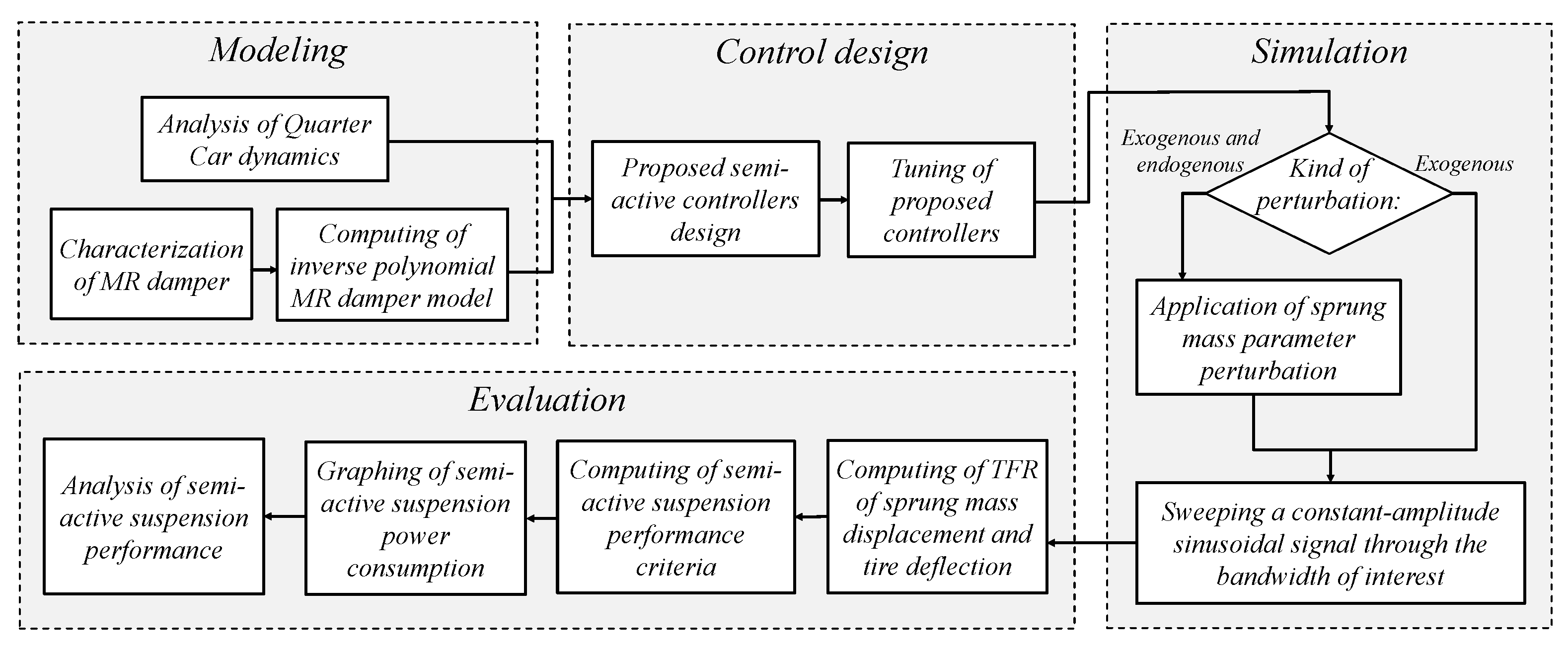

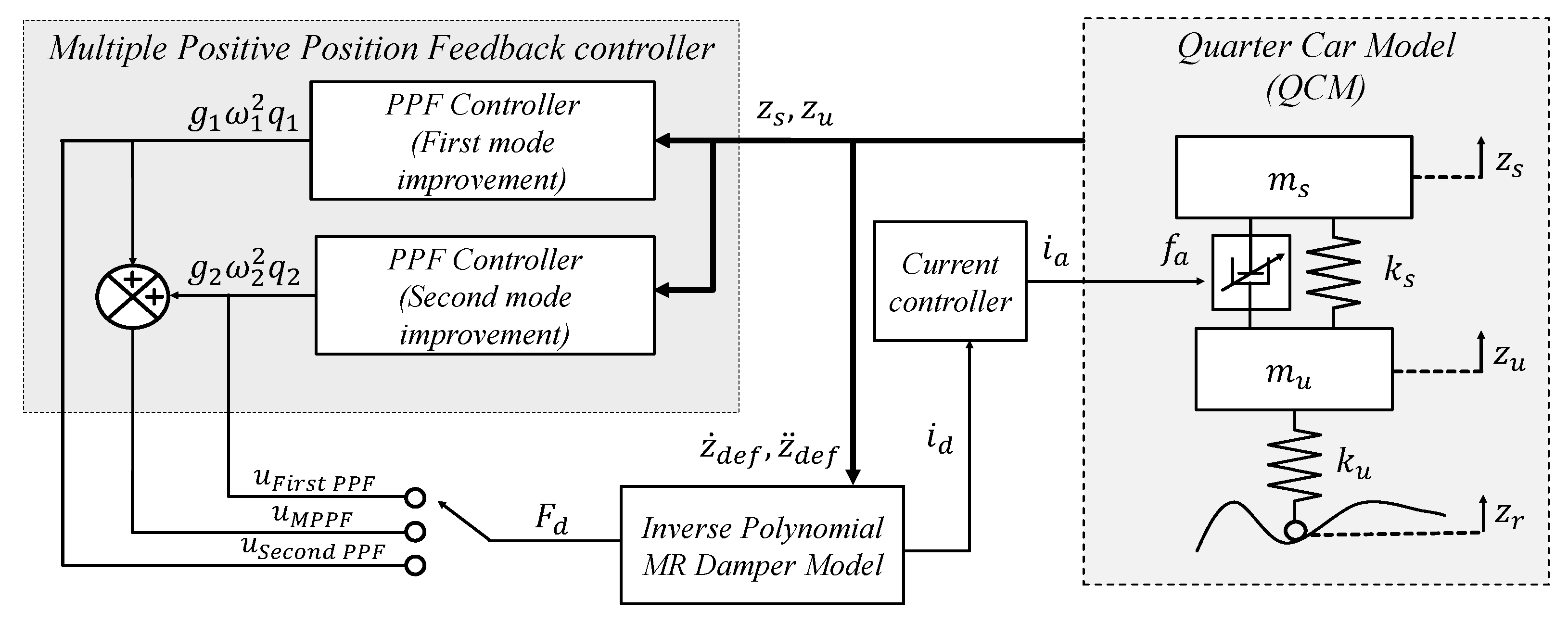

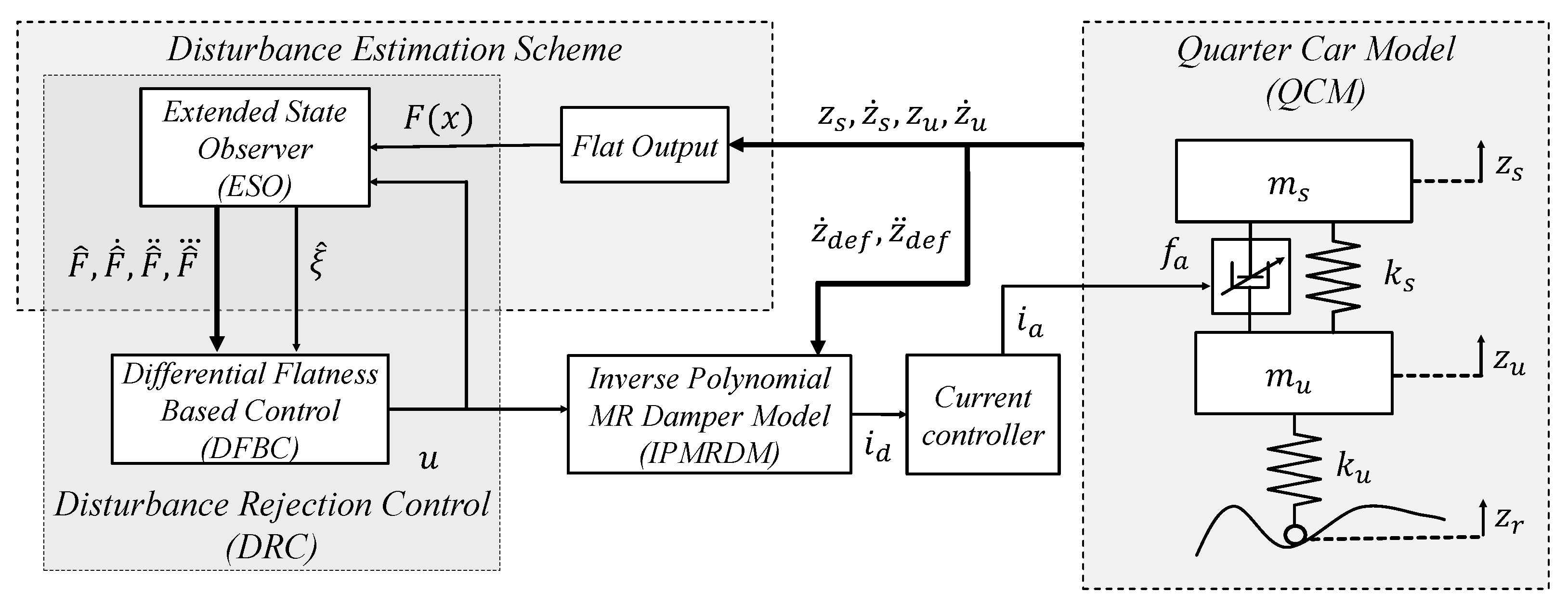
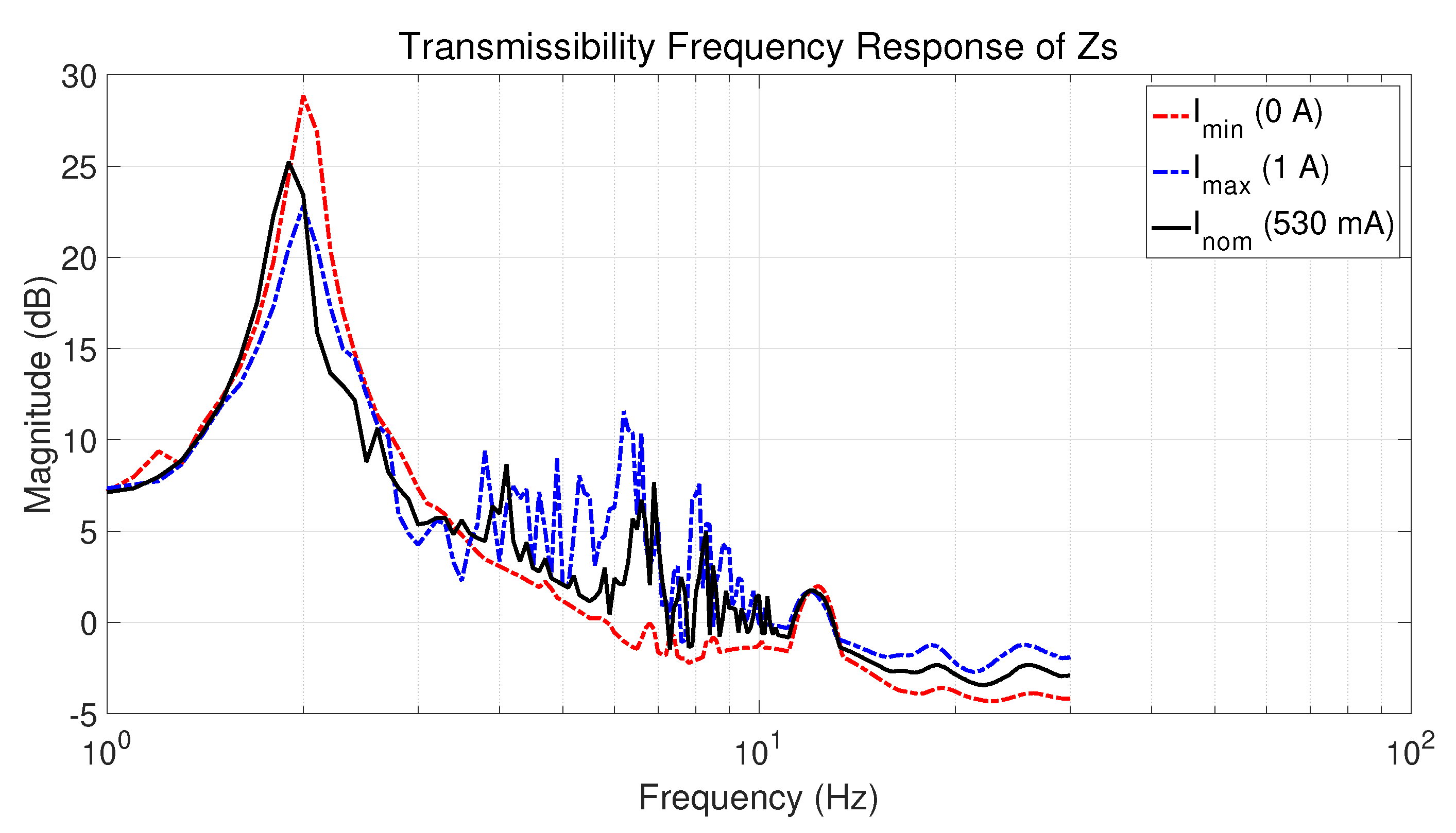



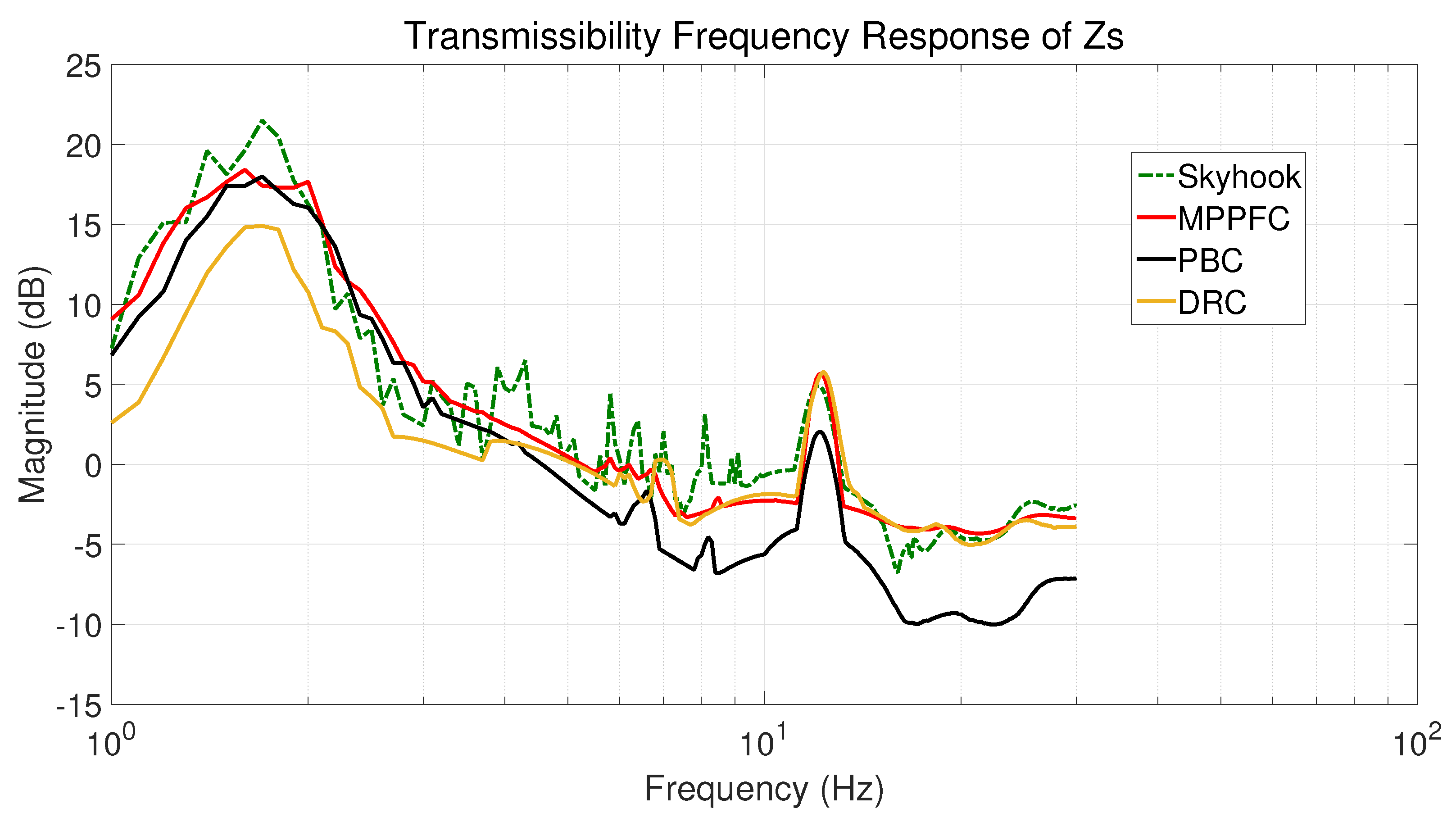
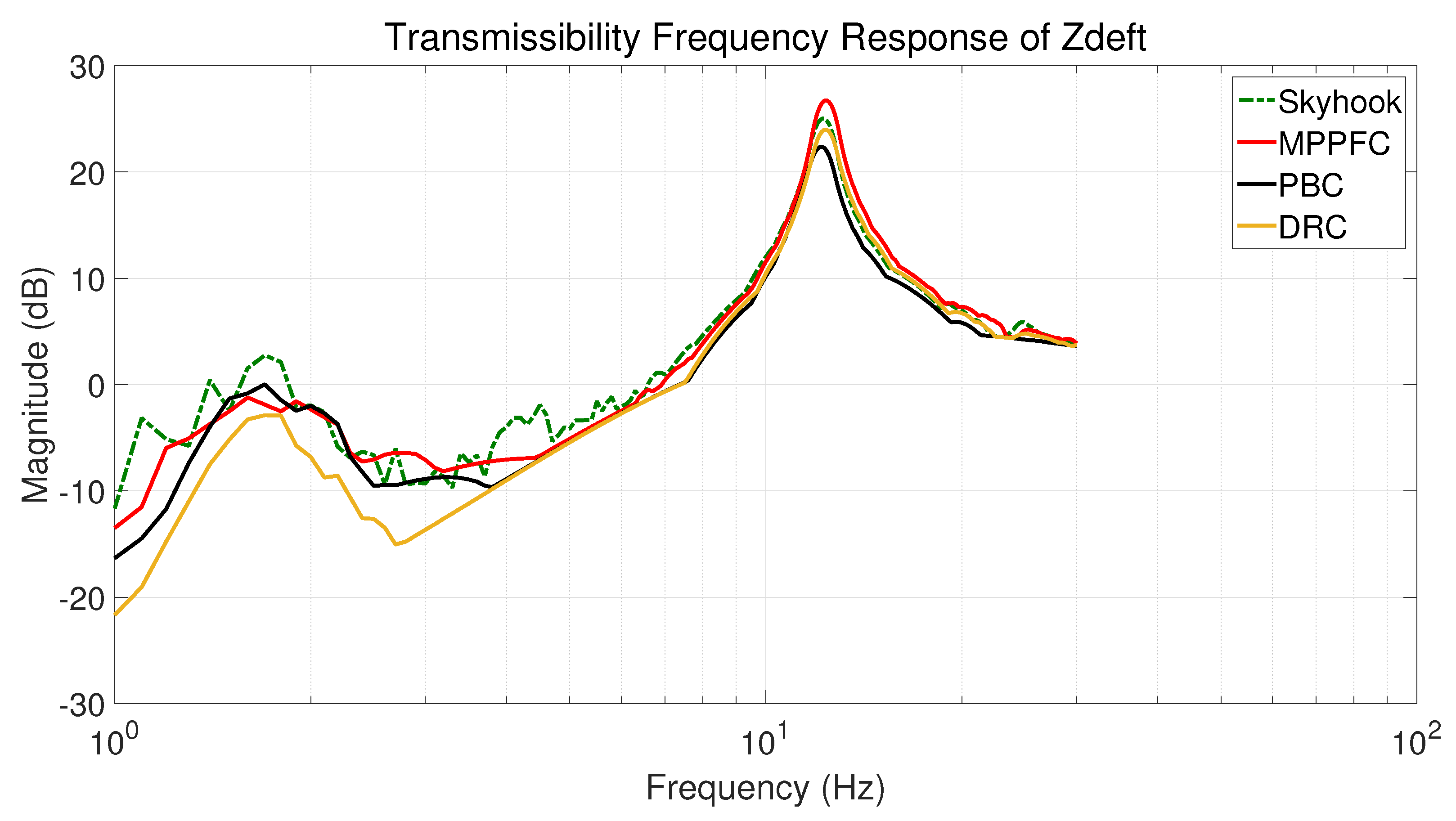

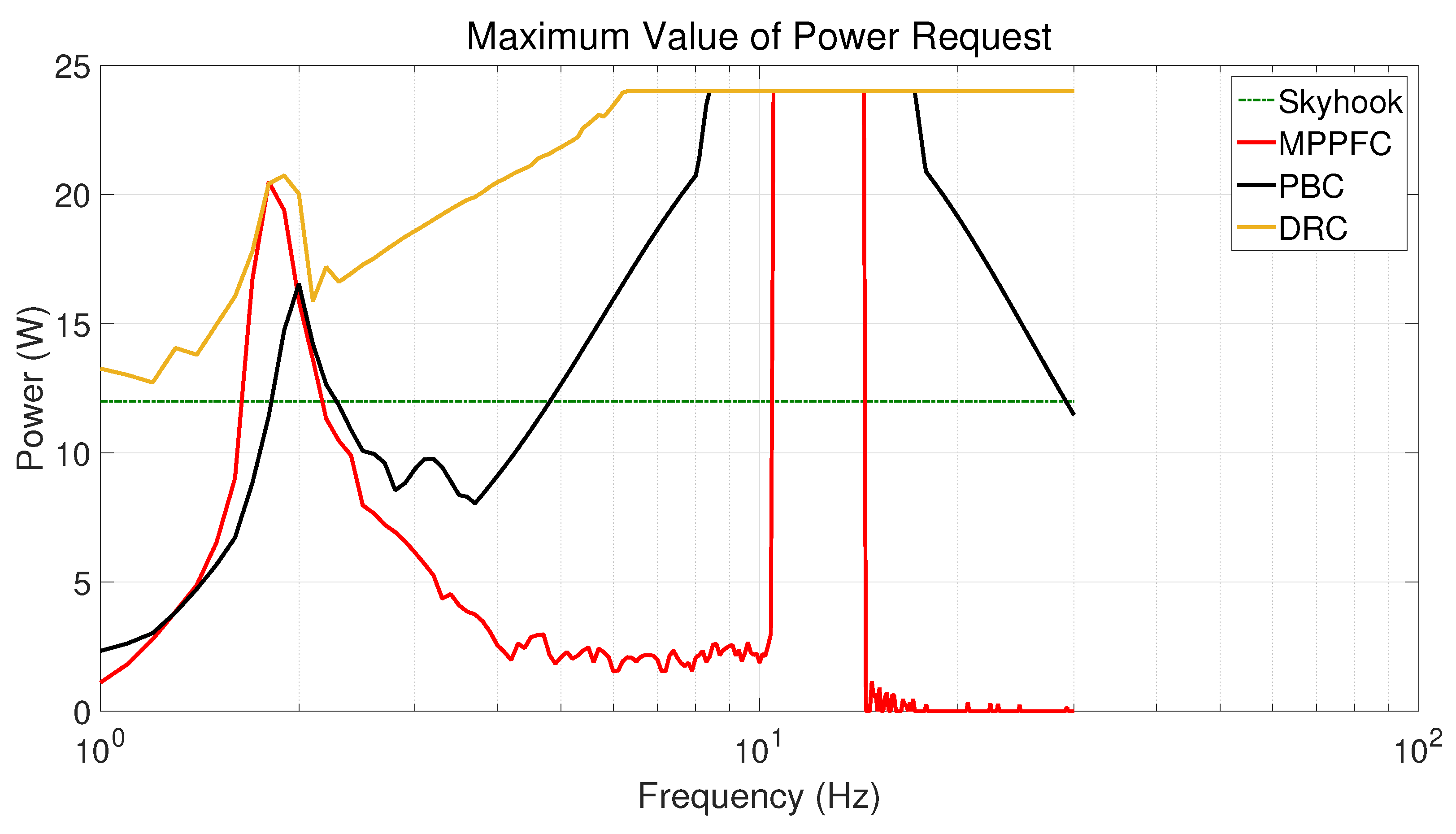
| 0 | 3.2679 | 224.8581 | −115.2069 | −259.8339 |
| 1 | 7.9904 | 50.1593 | 8.2080 | 51.2396 |
| 2 | −0.0836 | −0.7803 | 0.2687 | 0.7833 |
| Parameter | Description | Value |
|---|---|---|
| Minimum sprung mass | 100 kg | |
| Nominal sprung mass | 135 kg | |
| Maximum sprung mass | 187.5 kg | |
| Unsprung mass | 27.8 kg | |
| Suspension stiffness | 18.775 kN/m | |
| Tire stiffness | 148.2886 kN/m | |
| Suspension damping | 100 Ns/m | |
| Maximum input current permissible for MRD | 2 A | |
| Maximum damping force provided by MRD | 1750 N | |
| Upper test frequency | 30 Hz | |
| Lower test frequency | 1 Hz | |
| Disturbance signal amplitude | 1 cm | |
| P | Test periods | 10 |
| PPF Frequency | 12 rad/s or 72 rad/s | |
| PPF Damping ratio | 1.0 | |
| g | PPF gain constant | 5.0 or 1.0 |
| i-th MPPF Frequency | 12 rad/s and 72 rad/s | |
| i-th MPPF Damping ratio | 1.0 | |
| i-th MPPF gain constant | 5.0 and 1.0 | |
| PBC gain constant | 0.44 | |
| Angular frequency for DRC scheme | 20 rad/s | |
| Damping ratio for DRC scheme | 3.0 | |
| Angular frequency for LESO | 150 rad/s | |
| Damping ratio for LESO | 4.0 | |
| T | Sample time for simulation | 100 s |
| Controller | Comfort | Road-Holding |
|---|---|---|
| mA | 1.0 | 1.0 |
| A | 0.5766 | 0.7324 |
| A | 1.1262 | 1.2723 |
| Skyhook scheme | 1.3242 | 1.2379 |
| PPF (comfort approach) | 0.8866 | 0.7365 |
| PPF (road-holding approach) | 1.6428 | 0.8981 |
| MPPF scheme | 2.2926 | 0.9012 |
| Passivity-based scheme | 3.1954 | 1.9634 |
| DRC scheme | 5.1122 | 1.4534 |
| Controller | Comfort | Road-Holding |
|---|---|---|
| mA | 1.0 | 1.0 |
| A | 0.5747 | 0.7352 |
| A | 0.8047 | 1.2691 |
| Skyhook scheme | 1.4319 | 1.2359 |
| PPF (comfort approach) | 0.8602 | 0.7396 |
| PPF (road-holding approach) | 1.1997 | 0.9011 |
| MPPF scheme | 1.8206 | 0.9050 |
| Passivity-based scheme | 2.3945 | 1.9672 |
| DRC scheme | 3.6119 | 1.4550 |
Publisher’s Note: MDPI stays neutral with regard to jurisdictional claims in published maps and institutional affiliations. |
© 2021 by the authors. Licensee MDPI, Basel, Switzerland. This article is an open access article distributed under the terms and conditions of the Creative Commons Attribution (CC BY) license (http://creativecommons.org/licenses/by/4.0/).
Share and Cite
Floreán-Aquino, K.H.; Arias-Montiel, M.; Linares-Flores, J.; Mendoza-Larios, J.G.; Cabrera-Amado, Á. Modern Semi-Active Control Schemes for a Suspension with MR Actuator for Vibration Attenuation. Actuators 2021, 10, 22. https://doi.org/10.3390/act10020022
Floreán-Aquino KH, Arias-Montiel M, Linares-Flores J, Mendoza-Larios JG, Cabrera-Amado Á. Modern Semi-Active Control Schemes for a Suspension with MR Actuator for Vibration Attenuation. Actuators. 2021; 10(2):22. https://doi.org/10.3390/act10020022
Chicago/Turabian StyleFloreán-Aquino, Kevin Herubiel, Manuel Arias-Montiel, Jesús Linares-Flores, José Gabriel Mendoza-Larios, and Álvaro Cabrera-Amado. 2021. "Modern Semi-Active Control Schemes for a Suspension with MR Actuator for Vibration Attenuation" Actuators 10, no. 2: 22. https://doi.org/10.3390/act10020022
APA StyleFloreán-Aquino, K. H., Arias-Montiel, M., Linares-Flores, J., Mendoza-Larios, J. G., & Cabrera-Amado, Á. (2021). Modern Semi-Active Control Schemes for a Suspension with MR Actuator for Vibration Attenuation. Actuators, 10(2), 22. https://doi.org/10.3390/act10020022






